Seattle Public Schools will begin the academic year on schedule September 3 under new one-year contracts that significantly expand teacher authority over classroom disruptions, reflecting growing concerns about student behavior and educator safety throughout the district.
The Seattle Education Association and district leadership reached agreement before the August 31 contract expiration, avoiding a repeat of the 2022 strike that delayed the school year’s start. The expedited negotiation process resulted in focused changes rather than comprehensive contract revision, addressing immediate concerns while postponing broader discussions amid district leadership and financial uncertainty.
The most substantial changes involve classroom discipline protocols that give teachers explicit authority to remove disruptive students for up to two days or until administrators discuss intervention strategies. Under the new language, principals cannot return removed students to classrooms without first conferring with teachers about support plans and consequences.
Seattle Education Association President Girard Montejo-Thompson characterized this as addressing a fundamental classroom management problem where students returned to class “without any meaningful consequences or follow-up,” undermining teachers’ ability to maintain safe learning environments. The change reflects broader regional discussions about student discipline policies and their impact on educational effectiveness.
The contract modifications align with state law changes that codify teacher removal authority while requiring “corrective action” attempts before student removal except during emergencies. This balance attempts to address both teacher safety concerns and educational continuity for all students, though implementation effectiveness will depend on administrative follow-through.
All bargaining units covering nearly 6,000 workers will receive 2.5% salary increases, with paraprofessionals and office staff gaining additional compensation for technology professional development. The union had sought higher raises for support staff facing Seattle’s cost of living pressures, with some workers maintaining multiple jobs to afford housing in the region.
The $18 million contract cost includes nearly $7 million in unfunded obligations for the district’s general fund, adding pressure to ongoing financial challenges facing Seattle Public Schools. The district’s fiscal constraints limited negotiation flexibility while competing demands from federal policy uncertainty and leadership transitions influenced both parties’ approach to the agreement.
Safety provisions extend beyond classroom discipline to include protective equipment requirements for staff providing medical care and mandatory training for employees assisting students with personal needs. These requirements formalize existing practices while ensuring consistent implementation across schools with varying resources and student populations.
The contract requires principals to review discipline standards with staff during August professional development and share annual policy updates by December 1. This timeline provides structure for ongoing communication about safety protocols while allowing adjustment periods as school communities develop their approaches to student behavior management.
Staff members who experience threats, intimidation, or assault can now formally request safety support plans and reassignment opportunities. While the district previously offered such accommodations, codifying these rights in the contract ensures consistent access and removes ambiguity about available protections.
The one-year duration reflects mutual recognition of ongoing uncertainties facing the district, including the absence of a permanent superintendent and potential federal education policy changes. This short-term approach allows both parties to address immediate concerns while preserving flexibility for more comprehensive negotiations as conditions stabilize.
For Seattle families, the contract changes may influence classroom dynamics and student experience as teachers gain clearer authority over learning environment management. The balance between maintaining educational access and ensuring classroom safety will require ongoing collaboration between educators, administrators, and families.
The agreement’s implementation will serve as a test case for other districts grappling with similar challenges around student behavior, teacher authority, and workplace safety. Success in improving classroom environments while maintaining educational equity could influence regional approaches to education labor negotiations and student discipline policies.







